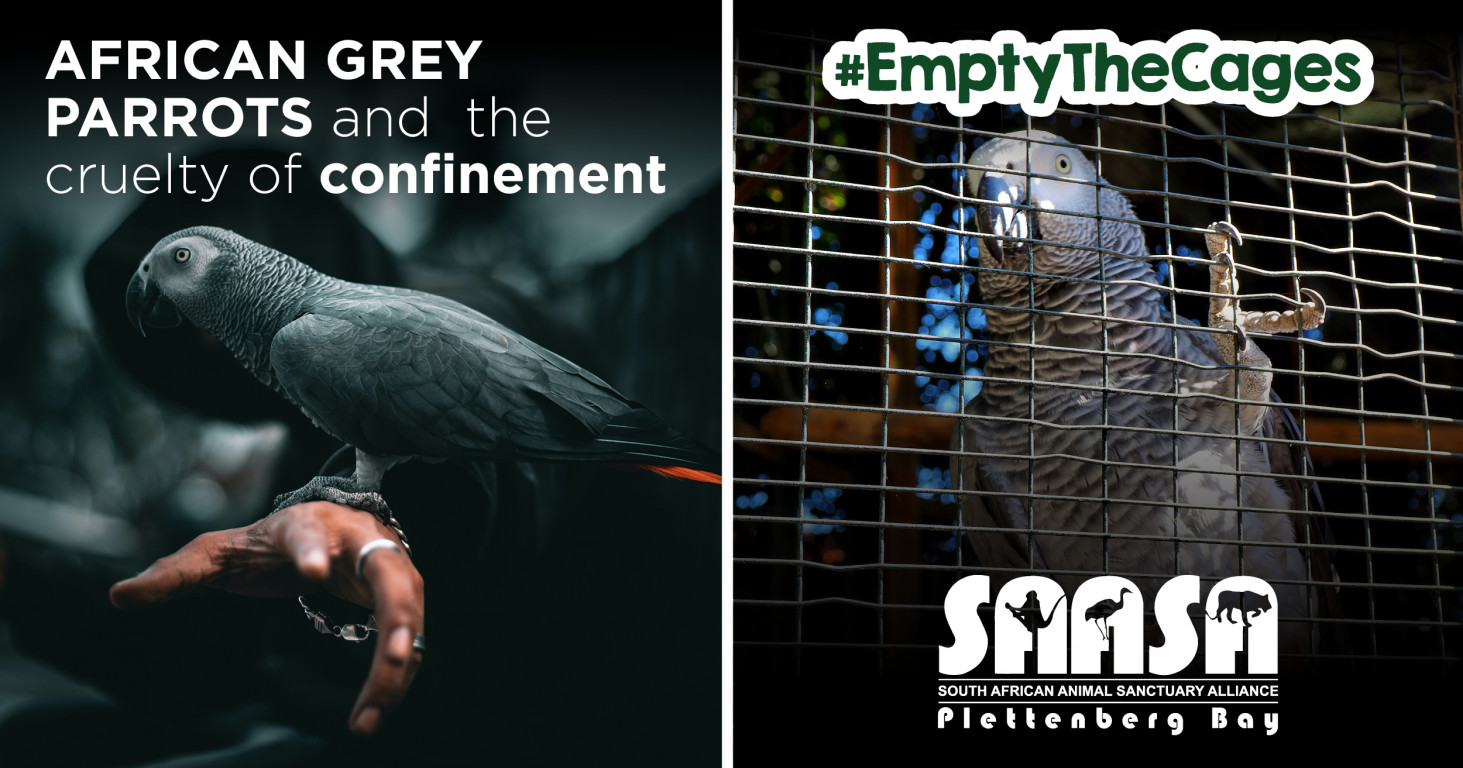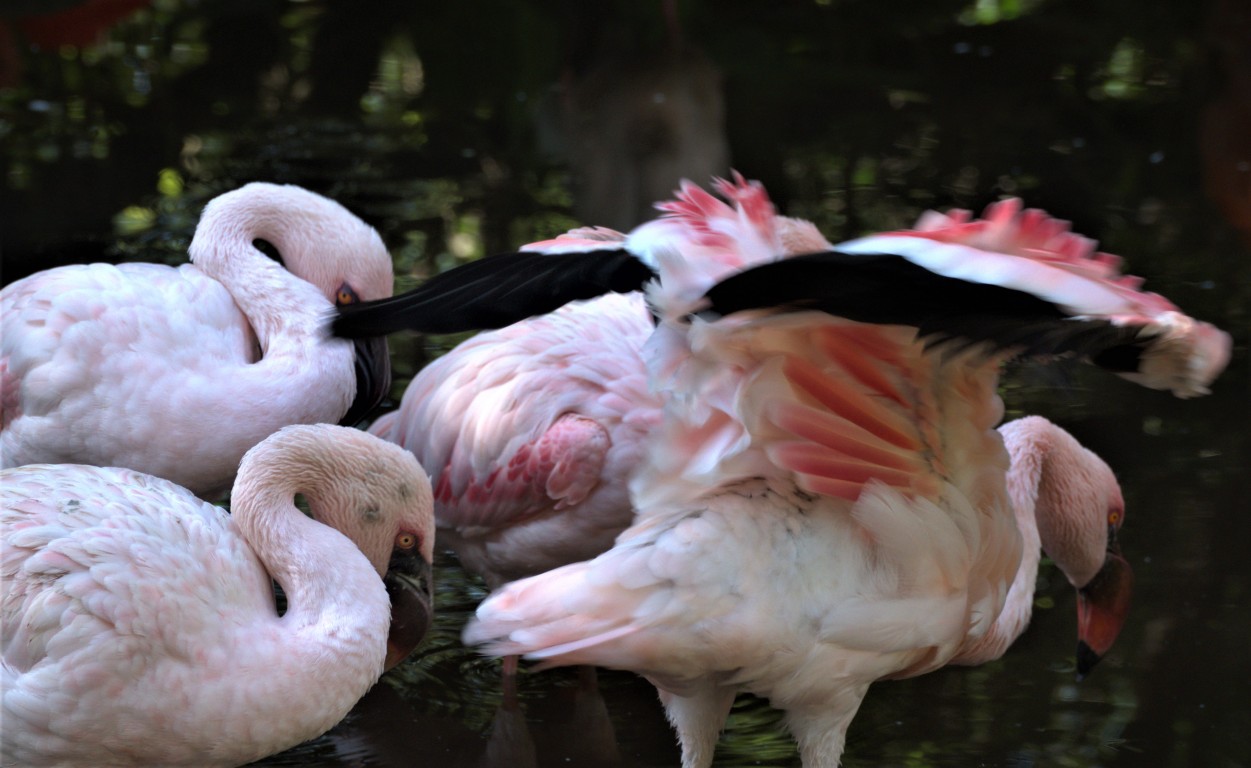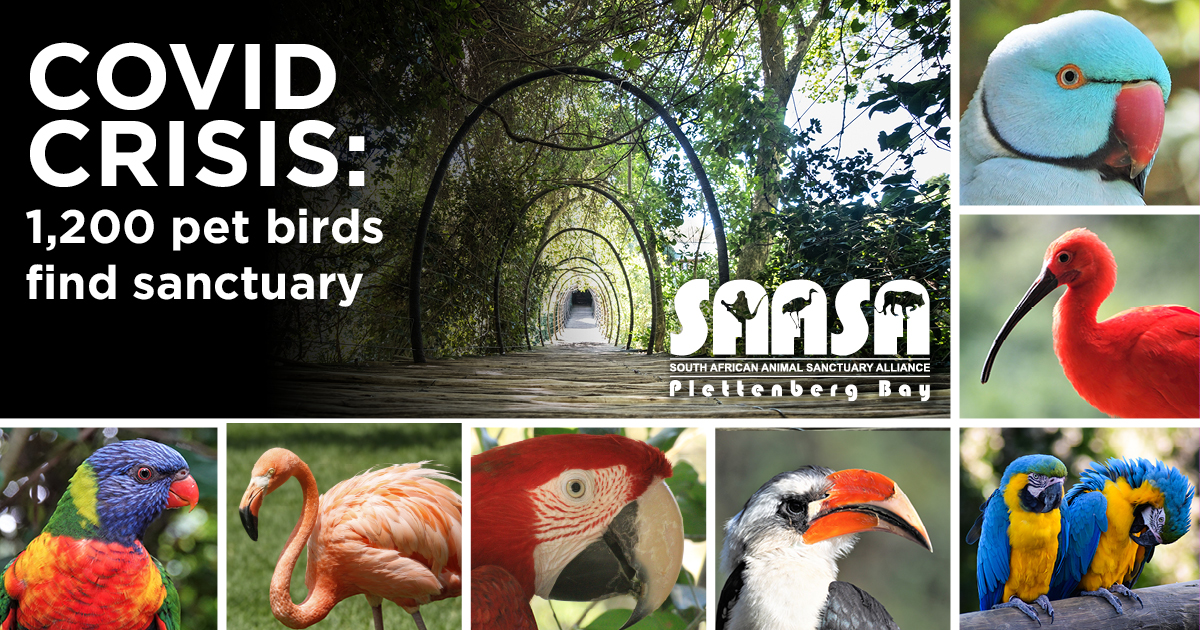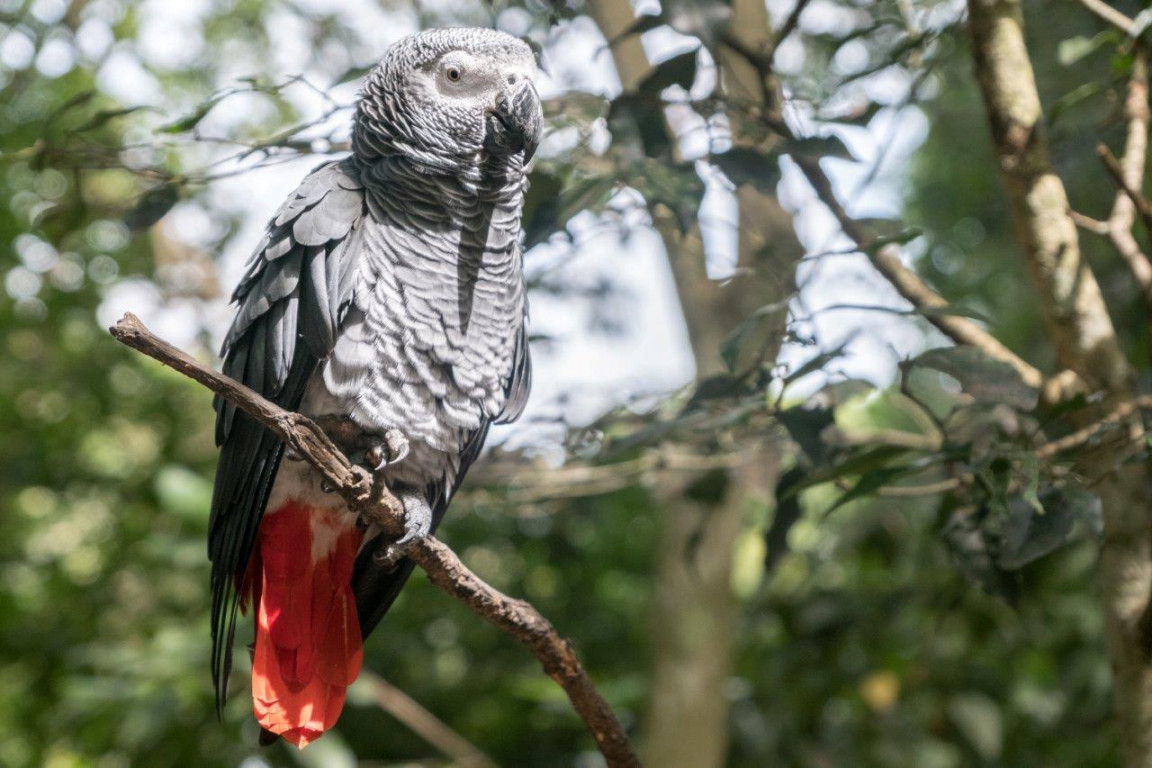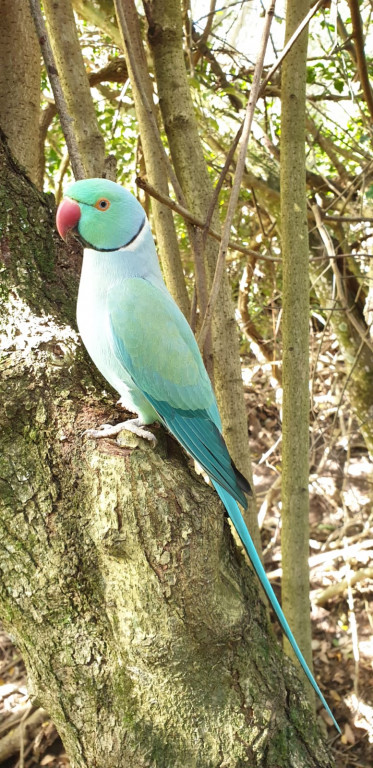The natural range of grey parrots – African greys and their close cousins, Timneh (or maroon tail) greys – extends across equatorial Africa from Angola to Kenya, and westwards to the Ivory Coast. They live socially in enormous flocks and usually prefer dense forests, although they do also inhabit the more open countryside of the savanna forests.
Their numbers are dwindling fast, though, and the species has been almost totally eliminated from the wild in some places: the Ghanian population, for example, fell by as much as 99% between 1992 and 2015 – a situation caused partly by capture for the pet trade, and partly by habitat destruction.
“One of the most heartbreaking things about African greys in captivity is that most of them are kept alone in small cages – and when you consider that are social birds that mate for life, and that they can live in captivity for up to sixty years, that’s a long time in solitary confinement,” said Birds of Eden curator, Isabel Wentzel.
“This is why we’d like to see an end to the African grey pet trade in South Africa.”
PROTECTED SPECIES
Although they move in large flocks in the wild, African grey parrots form monogamous pairs, each of which chooses its own tree for nesting – they favour cavities in the trees, and will strongly defend their nesting sites – with the hens producing between three and five eggs at a time. The incubation period is thirty days, during which the hen eats only food brought to her by her mate.
Although previously listed in Appendix II of CITES (the Convention on International Trade in Endangered Species of Wild Fauna and Flora), grey parrots were voted onto Appendix I at the Congress of the Parties to CITES in 2016 – putting them on a par with the world’s most endangered plants and animals (with, for example, tigers, gorillas, and with other species threatened with extinction).
This ‘up-listing’ means that wild specimens may no longer be traded internationally for commercial purposes, that trade is limited to very few situations (research, etc.), and that commercial breeders of captive-bred birds must register via the CITES secretariat in order to continue trading. (It’s significant that South Africa was one of the few nations that voted against up-listing African greys to CITES I in 2016.)
Prized for their ability to mimic the human voice and other sounds, African greys now rank amongst the world’s most popular avian pets – and therefore as one of its most trafficked birds, and certainly its most trafficked parrot.
Despite CITES sanctions, enormous numbers of African greys are still captured in the wild. This is partly due to breeder preference: wild-caught birds will usually begin breeding immediately, whereas captive-bred birds will only breed from about four years of age. Additionally, wild-caught birds are generally cheaper than captive-bred birds – which makes it possible to sell them more quickly and more easily.
The risk for wild-caught birds is heavy, though: more than 50% of them die even before they reach the market. It’s estimated that 10% die on planes, a further 24% die when being transported by road over long distances, or as a result of having been caught as fledglings, and between 10% and 40% die as a result of mistreatment by local buyers.
In captive-bred situations, on the other hand, breeders will often hatch the eggs in incubators, and hand-raise the fledgelings to produce tame parrots conditioned as pets – but of little further use to the breeders, except for sale as individuals. Since these birds are not raised by their natural parents in their natural habitats – and in their natural flocks – they lack essential life skills, including the ability to socialise, control of their flying skills, etc.
SOUTH AFRICA
Despite the fact that they’re not indigenous to South Africa, this country breeds more African greys than any other, producing about 80% of the world’s supply of captive-bred birds.
In 2016, the Parrot Breeders Association of South Africa was reporting that its members were producing about 67,000 chicks a year – 90% of which are exported – but that demand existed for as many as 30,000 more: 100,000 birds a year.
Additionally, South Africa’s porous borders and poor import control makes it an easy hopover for smuggled birds which are transported from Equatorial Africa via Mozambique – with its equally porous borders.
With 7,000 captive-bred birds entering the market in South Africa every year, the size of the problem is growing exponentially, especially as many of the birds end up as unwanted pets – because their owners can no longer afford their keep, because they’re moving into smaller homes, because they’ve passed away and their heirs have no interest in their birds, because they’ve realised the cruelty of keeping individual parrots in small cages, etc., etc.
“Many of these people contact us to ask if we can offer their birds a better life,” said Isabel. “They want them to fly with others of the same kind.”
SANCTUARY
Birds of Eden – a member of SAASA (the South African Animal Sanctuaries Alliance) – cares for almost 4,500 birds from more than 220 species in its 23,000 square metre (2 hectare) single-span dome aviary, which is the largest of its kind in the world.
“Our aim is to meet and exceed the requirements of the Global Federation of Animal Sanctuaries, which defines sanctuaries as facilities that provide ‘temporary or permanent safe haven to animals in need while meeting the principles of true sanctuaries’,” said SAASA’s CEO, Tony Blignaut.
These principles include providing excellent and humane care in a non-exploitative environment, and adherence to ethical policies regarding tours, trade, exhibition, breeding, the acquisition and dispossession of animals, and more.
“For a long time, we couldn’t accommodate African greys at Birds of Eden,” said Isabel. “Although they aren’t aggressive to each other or to other species, we did find that they tended to destroy the forest, and also any wooden, man-made structures in the aviary – so we had to decline them.
“Eventually, though, the pressure on us forced us to build a separate, 900 square metre, landscaped, free-flight aviary – 4,2 metres high – which we opened at the time of lockdown, and which now houses about 135 African greys.”
Many of the birds came from other rescue organisations, while one collection of thirteen individuals came from a deceased estate.
Like its sister SAASA facilities – Monkeyland and Jukani in The Crags, and Monkeyland-KZN in Ballito, KwaZulu-Natal – Birds of Eden enforces a strict ‘no touch, #handsoff’ policy (the African grey aviary is not part of the normal tourist route at Birds of Eden, and visits are only allowed by special arrangements). Nevertheless, new arrivals are subjected to a rehabilitation process, which is vital for ensuring their proper assimilation into the flock.
“It begins indoors in a big parrot cage, where we can check on their eating patterns and get to know them; then we move them outdoors into a transition aviary in small groups of five to eight birds; and only after this do we release them into the free-flight aviary, where they can do as they wish,” said Isabel.
The aviary has been designed to accommodate birds that have been maimed to the point where they are unable to fly. “They’re strong climbers, and we make sure that they can access their food and water.”
While stressing that the sanctuary is definitely not soliciting for birds – it has almost as many as it can handle – Isabel noted that Birds of Eden receives calls almost weekly from owners. On the odd occasion when it does decide to consider accepting specimens, the sanctuary insists that they must test negative for diseases like Psittacosis, which could spread to other birds in the centre – and, in some cases, to their curators, too.
“We’re doing everything we can for the few individuals in our care – but the real win will come when the public begins to reject African greys and other threatened species as pets, and cuts off the supply line to the breeders and smugglers who see them as purely a commodity to be traded for cash,” said Tony.
“That’s what #EmptyTheCages is all about.”
ENDS
2 June, 2022
AUTHOR
Martin Hatchuel www.tourismcontent.co.za
MEDIA ENQUIRIES
Lara Mostert, lara@co.za +27(0)82 979 5683
RESOURCES
- Epsley, Simon: ‘Shades of Grey ~ The journey from a bustling forest community to solitary live in your living room.’ Africa Geographic, 2014 https://africageographic.com/stories/shades-of-grey/
- Jordan, Rick: ‘African Grey Parrots moved to CITES Appendix I.’ AFA Watchbird https://journals.tdl.org/watchbird/index.php/watchbird/article/download/3770/3745
- Wikipedia: ‘Grey parrot’ https://en.wikipedia.org/wiki/Grey_parrot
#EmptyTheCages



